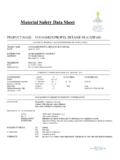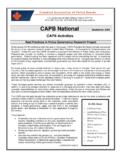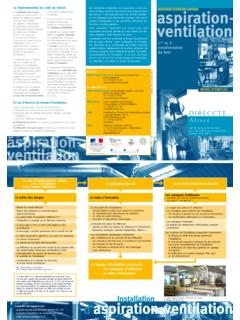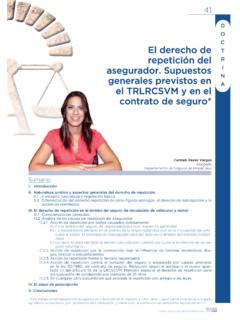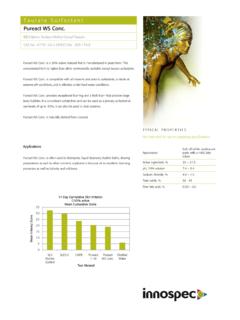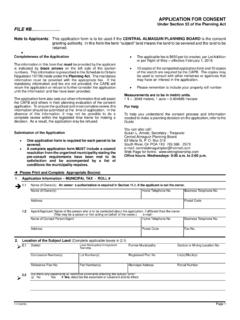Transcription of Comparison of Virulence Determinants of Different Strains ...
1 Aziz Niazi 1. Comparison of Virulence Determinants of Different Strains of Haemophilus influenzae. Niazi A. Rahman School of Biomedical Science, Curtin University of Technology, Perth WA. Introduction .. 1. Capsule .. 2. Fimbrial adhesion .. 3. HMV1 and HMV2 Adhesins .. 4. Hap adhesin .. 5. Hia and Hsf adhesins .. 5. Opacity associated protein (Oap) .. 6. Haemocin .. 6. IgA protease .. 6. Lipooligosaccharide .. 7. Outer Membrane Proteins (OMPs) .. 7. Protein D (PD) .. 8. Acknowledgment ..11. References ..11. INTRODUCTION. Haemophilus influenzae is a small, nonmotile Gram-negative coccobacillus which was first described in 1982. It is generally aerobic but can grow as a facultative anaerobe too. Haemophilus influenzae was mistakenly considered to be the causative agent of the common flu, until the discovery of the influenza virus in 1933 as the causative agent; however, Haemophilus influenzae is still responsible for causing many other diseases.
2 Encapsulated Strains of Haemophilus influenzae isolated from cerebrospinal fluid are coccobacilli, to to to m. Non-encapsulated organisms from sputum are pleomorphic and often exhibit long threads and filaments. The organism may appear Gram-positive unless the Gram stain 1,830,137 base pairs of DNA in a circular procedure is very carefully carried out (16). chromosome which has 1740 protein-coding genes Furthermore, as far as molecular analysis is and 58 tRNA and 18 other RNA genes. (Figure 1). concerned, Haemophilus influenzae was the first FIG 1: The genome of H. influenzae (16). free living organism whose genome was completely sequenced by scientists, containing Aziz Niazi 2. Haemophilus influenzae is a part of normal influenzae diseases are caused by Haemophilus bacterial flora of the upper respiratory tract, influenzae type b and non-typeable Strains , makes especially oropharynx and nosopharynx in almost it essential to know and compare the Virulence 90% of the adult population, they are opportunistic factors of the Haemophilus influenzae Strains in pathogens that usually live in the host body order to better understand which Virulence factor without causing any harm or diseases and wait for or factors are most responsible for establishment an opportunity such as a viral infection or reduced of the disease.
3 The purpose of this paper is to immunity (8, 18, 21). Studies show that most of review and compare the Virulence Determinants of isolates sampled from the oropharynx of adults are Haemophilus influenzae Strains . non-encapsulated Strains of Haemophilus influenzae, although encapsulated Strains of There are several main Virulence factors in Haemophilus influenzae can be isolated in the Haemophilus influenzae such as: capsule, fimbrial normal upper respiratory tract of both adults and adhesin, HMW1 and HMW2, Hap Adhesin, Hia children. There are 6 Different encapsulated and Hsf Adhesins, Opacity-associated Protein A. serotypes of Haemophilus influenzae (a, b, c, d, e (OapA), Haemocin, IgA protease, and f), the most virulent form of which is Lipooligosaccharide, Outer Membrane Proteins Haemophilus influenzae type b (18, 20).
4 In infants and Protein D (18, 21). (see table 1). To better and small children Haemophilus influenzae causes understand the characteristics of these Virulence bactraemia, epiglottitis, otitis media, acute factors, each of them will be briefly explained pharyngitis bronchitis pneumonia, acute bacterial below. meningitis, endocarditis, and conjunctivitis. Generally, Haemophilus influenzae infections CAPSULE. seem to occur just in human. All of the 6 encapsulated Strains of Haemophilus Currently, with the availability of the Hib influenzae have capsule as a Virulence factor. The conjugate vaccine, the incidence and subsequently capsule is composed of polysaccharide containing the prevalence of the disease has dramatically two hexose sugars as subunit carbohyhdrates. But dropped; but, according to scientists, Hib still the type b polysaccharide is the only capsular type remains a major causative agent of lower which has two pentose monosaccharide instead of respiratory tract infection in young children, the previously mentioned hexose sugars in other mostly in third world countries in which the serotypes (18, 21).
5 Also, the type b capsule is vaccine is not routinely applied. polyribosyl-ribitol-phosphate (PRP) which is composed of linear teichoic acid containing ribose, Early studies revealed that all isolates of H. ribitol - an alcohol containing a five carbon sugar- influenzae are Different in terms of pathogenic and a phosphate linked by phosphodiester bonds potential. It is very important to mention that most and is a critical determinant of Virulence . systemic isolates express the type b capsule, According to scientists, even though the Virulence whereas most respiratory tract isolates contain of type b Haemophilus influenzae is multifactorial, unencapsulated, referred to as non-typeable (12, still the PRP capsule has a significant role in this 18). The fact that most of the Haemophilus Aziz Niazi 3.
6 Regard. This capsule helps Haemophilus influenzae implies that hcsA and hcsB genes are to avoid phagocytosis and opsonization by complementary in the transport of polysaccharide neutrophils. Moreover, Haemophilus influenzae across the outer membrane and to the cell surface capsule does not induce alternative complement and are essential for Virulence , (11, 13). It is worth pathways; therefore, the bacterium invades the noting that the process of encapsulation of type b blood or CSF without aggravating an organism is directly related to a decrease in the inflammatory response and attracting phagocytes ability of the microorganism to adhere or to invade (13, 16, 20, 21). the host cells. In this regard, some mutations The genetic base of the production of the PRP causing the loss of a copy of the duplication at the capsule is multifaceted and engages both capsular cap B locus result in capsule-deficiency that and non-capsular genetic Determinants .
7 The genes results in an increase in bacterial ability to adhere involved in the expression of Haemophilus (50-fold) and invade (300-fold) the host epithelial influenzae type b capsule are present as a cells. Meanwhile, the re-establishment of the duplication of an approximately 18-kb DNA encapsulation in mutated Strains by segment (the Cap b locus). The only strain of transformation, results in a considerable reduction Haemophilus influenzae that contains this in both adherence and invasion of type b serotype. duplicate-gene arrangement is Haemophilus The capsule of Haemophilus influenzae Strains , influenzae type b, while other encapsulated especially type b PRP, has been the basis of serotypes only contain a single copy of the gene. vaccine development for many years. Some recent evidence show that even capsule- deficient type b Haemophilus influenzae has also a FIMBRIAL ADHESION.
8 Single copy of the gene capB and is, therefore, less Fimbriae are the colonization factors of the virulent than the normal type b (18, 21). Therefore, Haemophilus influenzae, meaning they mediate capB gene amplification is undertaken only in the bacterial adherence to human cells. Fimbriae normal non-deficient type b Haemophilus are found on type b encapsulated and influenzae stain and is one of the characteristics of unencapsulated Strains of Haemophilus influenzae. this highly virulent strain . Further studies show The adherence of Haemophilus influenzae to that this cap b locus consists of three functionally human mucosal and epithelial cells plays a distinct regions, named regions 1, 2 and 3. Region significant role in infections and fimbriae play a 3 contains the hcsA and hcsB genes.
9 If hcsA is considerable role in adhesion of the inactivated, it will lead in a partial decrease in microorganism to host cells (9). surface-associated polysaccharide and an increase in the amount of polysaccharides in the periplasm, Some fimbriae facilitate the haemagglutination while the outcome of the inactivation of hcsB and adherence of the microorganism to human alone or of both hcsA and hcsB is a total loss of mucosal cells, especially to oropharyngeal surface-associated polysaccharide and the epithelial cells, but on the other hand, they inhibit gathering of polysaccharide in the periplasm. This the mucosal cell invasion. The fimbriae of Haemophilus influenzae are composed of a 24. Aziz Niazi 4. kDas major protein (HifA), two minor proteins of discussed later. This protein also has the adherence kDa (HifD) and (HifE) molecular capability to human cells.
10 Although this protein weight. HifE has the ability to haemagglutinate shows a huge interstrain heterogeneity between and adhere to epithelial cells, and is located on the Different non-typeable Strains , there are still some tip of the Haemophilus influenzae fimbriae. Any conserved regions in this protein that have been mutation in the HifE gene results in a reduced nominated as candidate vaccine antigens. ability of the microorganism in haemagglutination and adherence. In fact, fimbriae facilitate HMV1 AND HMV2 ADHESINS. adherence to human cells, by binding to HMW1 and HMW2 are the major Virulence glycoproteins and glycolipids present on the factors of non-typeable Haemophilus influenzae respiratory mucin proteins (21). The gene for these Strains ; they are high-molecular weight, non-pilus proteins (HifA, HifD and HifE) exist as a single- adhesins that were initially identified as the main copy cluster together with two other genes (HifC targets of the human serum.)
